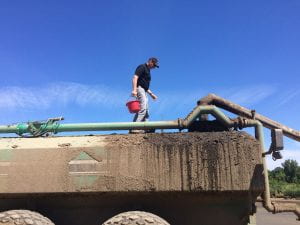
Farmers now have a new way to apply biocontrol nematodes to protect crops critical to dairy and livestock agriculture, thanks to research funded by the Northern New York Agricultural Development Program.
“Dairy farmers and crop growers have been interested in biocontrol nematodes since we proved their effectiveness at reducing populations of the alfalfa snout beetle, the most destructive pest of alfalfa, and now see potential to do likewise with corn rootworm, a significant threat to field corn production,” said Elson Shields, Ph.D., Cornell University, Ithaca, N.Y.
Shields pioneered the use of a combination of two native NY-adapted nematodes for pest management in field crops, berries, and other crops. The application of biocontrol nematodes is now being tested in multiple crops across the U.S.
In 2018 and 2019, Cornell Cooperative Extension Field Crops Specialist Michael E. Hunter developed a project to test application of the biocontrol nematodes via liquid manure. The current protocol applied the biocontrol nematodes in a water solution in the evening hours due to the nematodes’ sensitivity to U/V rays.
Hunter conducted field trials on 12 farms in Northern New York over the two-year project. He explained the hypothesis behind his trials.
“If biocontrol nematodes could be successfully established through liquid manure application that would accomplish significant benefits: combining two field operations into one to save time and labor, protecting the nematodes from damaging U/V light so application can be made at any time of day versus only evening hours, protecting crops using a biological means, and providing farmers with an additional method for application to encourage use of this biocontrol,” Hunter explained.
Soil sampling in 2018 confirmed establishment of the bicontrol nematodes applied in liquid manure in all trial fields on the six participating farms. In 2019, Hunter achieved successful establishment at a lower rate of nematodes per acre.
“The 2019 field data shows the lower rate of application is just as effective for establishing the biocontrol nematodes and lowers the cost to encourage farmers to adopt the use of this biocontrol,” Hunter said.
The complete “Evaluation of Alternative Application Methods of Biocontrol Nematodes in Alfalfa and Corn” report is posted at www.nnyagdev.org.
Funding for the Northern New York Agricultural Development Program is supported by the New York State Legislature and administered by the New York State Department of Agriculture and Markets. For more information, see www.nnyagdev.org.

